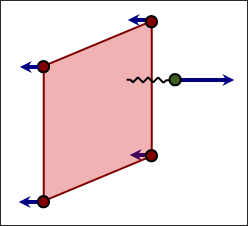Contact Treatment
- Penalty Method is the most commonly used in explicit codes and can be found in most of the Radioss interfaces
- Lagrange Multiplier Method (/LAGMUL and /INTER/LAGMUL) is used in special case studies
Penalty Method

Figure 1. Segment Definition

Figure 2. Gap and Penetration

Figure 3. Reaction Force in Interface
Contact ends when the penetrated node is completely pushed out of the gap. Therefore, the elastic spring and the reaction force are removed.
It is worthwhile to note that the contact interfaces with penalty method are fully compatible will all kinematic conditions (for example, rigid body, imposed velocity, etc.).
Lagrange Multiplier Method (/LAGMUL and /INTER/LAGMUL)
Contrary to the penalty method, the Lagrange Multiplier method is purely mathematical and does not require physical elements (springs) to model contact. A nonlinear system of equations is solved to account for contact conditions. Therefore, there is no time step collapse due to high interface stiffness, but it takes more CPU time to do one cycle as new equations need to be solved by a nonlinear solver. The method has the advantage to stop secondary nodes at the contact surface (the contact condition is precisely satisfied); however the friction cannot be computed.